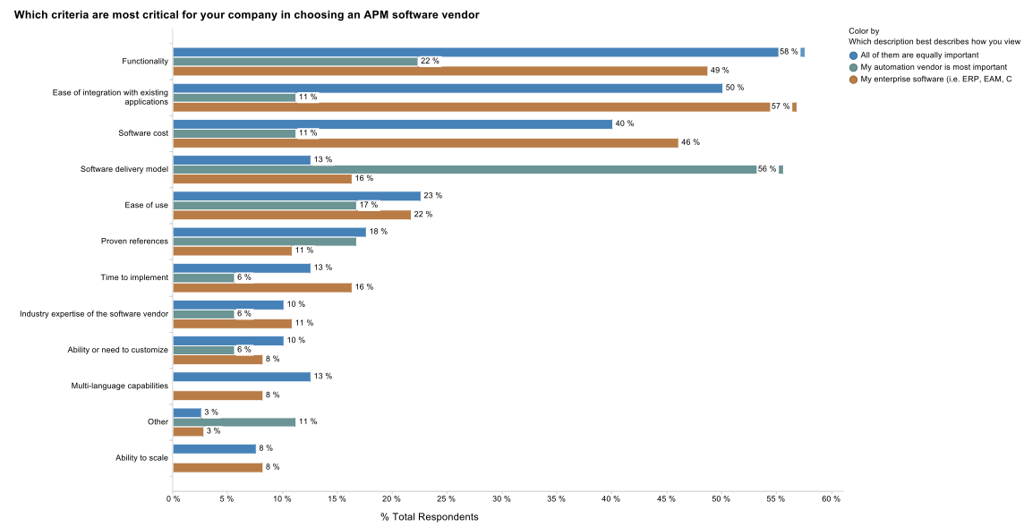Manufacturing companies have the reputation of being very cost-sensitive when it comes to procuring application software. Almost every end user company LNS Research engages with that is conducting a vendor selection exercise has cost as a key element of its process. However, despite manufacturing’s reputation, the reality is companies put cost behind both functionality and ease of integration when it comes to purchasing decisions for Asset Performance Management (APM) application procurement.
Click here to speak with Dan Miklovic
Additionally, when it comes to implementation and support services related to APM, cost as a factor drops even further. The research also shows interesting variation as to relative importance of key factors depending on how the business views the relative importance of the suppliers of APM solutions. When designing application and service provider selection processes, businesses should make sure they are prioritizing the right factors to ensure success.
Click here to see the graph in full size.
Users Viewing APM as a Multifunctional Program Highly Value Functionality
When we ask users about the relative value the different types of APM solutions bring to the table, the largest group are those that say enterprise level application providers, automation vendors, and specialized APM solution providers are all equally important. Of the nearly 100 respondents to this question, just over 40% opt for the equality option. Among this group 58% rank functionality as the most important selection criteria, they have while half of them put ease of integration as a top three criteria. Cost still comes in as third overall, but those making it a top criterion drops to just 40%. When it comes to services, cost also falls below implementation time and ties at 38% with both industry and specific package expertise with 38% users giving it top weighting in their selection process.
When Enterprise Software Leads in APM Mindset, Ease of Integration is Top Criterion
For the approximately 40% of the respondents who said their ERP/EAM applications were the most critical to their APM success the top criteria when it came to selecting a supplier was “ease of integration” with functionality coming in second. Not surprising given that it is the LNS contention that maximum value from enterprise applications is extracted when you have accurate real-time information combined with ready access for users across a wide spectrum of roles, using their interface of choice, most closely aligned with their role. This necessitates tight integration with not only other enterprise applications such as the engineering systems that might contain the asset hierarchy and the plant floor systems such as the Manufacturing Execution System (MES), Environment, Health, and Safety (EHS), and Quality systems any of which may trigger maintenance activities. Since these enterprise systems often have close alignment with the IT function, it is not surprising that the number one criteria used when selecting a systems integrator and services provider is the implementation methodology; followed closely by industry experience and cost.
When APM is Automation Driven the Software Delivery Model is the Top Criterion
More than two to one (at 56%) of the respondents, 20% indicated that they viewed their automation supplier as the key to their APM success. The 20% also said that the software delivery model was the criterion that most impacted their buying decisions with functionality a distant second (at 22%) and “ease of use” third (at 17%). These respondents tended to be more plant-centric in their job roles. This undoubtedly drives the preference leaning towards on-premise deployment. The same 56% ranked implementation methodology as their top criteria with references coming is a distant second with 28% and project tools in third place with 17%. The cost of services was dead last with only 6% of the respondents in this category identifying it as a key criterion.
Success Hinges on Making the Right Choices
So, if the market has spoken and the data says cost is not the top driving factor when choosing APM applications and services, how should a company embarking on an APM initiative prioritize its selection criteria? One thing the data does tell is that your role in the organization greatly impacts your priorities as well as your relationship to APM. Synthesizing a list from all the data leads LNS to believe that there are some common threads, particularly when we look at those companies pursuing APM and using it to drive Operational Excellence. Five key recommendations are:
- Take a balanced perspective on APM. The majority of companies do so, and they tend to have better performance than those that put the most of their “APM eggs” in one basket.
- DO NOT make cost your most important criterion, but keep it in the top five to ensure you are getting value from your investments.
- While the delivery model is not yet at the top of many companies list when evaluating applications, it should be going forward. Cloud and Big Data technologies are transforming the entire application space including APM. Make sure your supplier has a good Cloud story.
- Balance functionality with ease of integration. Too many companies make the mistake of favoring functionality, including ease of use and then fail to fully leverage that functionality because they cannot integrate their APM applications with the rest of their applications to ensure they have the best information available. The best approach looks at the total cost of ownership over the entire life of the investment and includes long-term integration costs as well as the cost of possible functional extensions.
- References matter! Make sure you talk to other users of either the applications or the services providers. Industry and application experience are easily assessed by checking references.